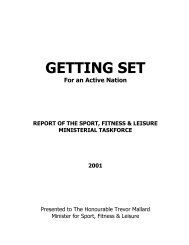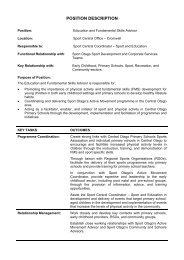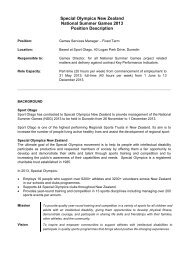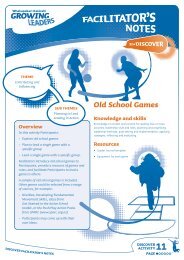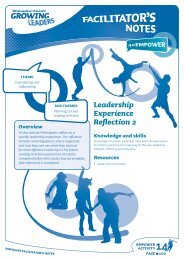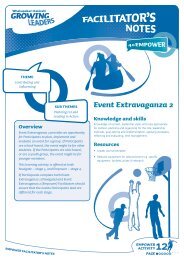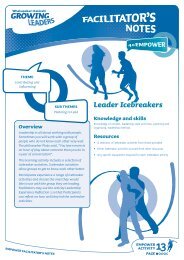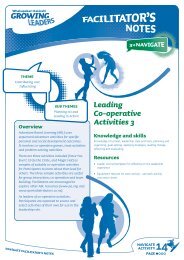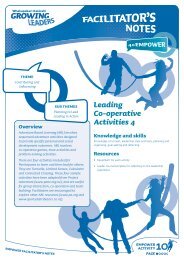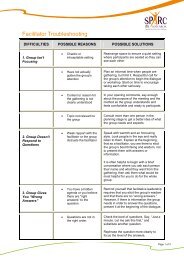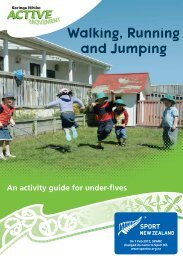9 Leading Physical Activity in the Playground 2
9 Leading Physical Activity in the Playground 2
9 Leading Physical Activity in the Playground 2
You also want an ePaper? Increase the reach of your titles
YUMPU automatically turns print PDFs into web optimized ePapers that Google loves.
vv vvavv<br />
THEME<br />
Contribut<strong>in</strong>g and<br />
Infl uenc<strong>in</strong>g<br />
SUB THEMES<br />
Plann<strong>in</strong>g to Lead<br />
<strong>Lead<strong>in</strong>g</strong> <strong>in</strong> Action<br />
Overview<br />
In this activity Participants experience<br />
physical activities and/or games that would<br />
be appropriate for <strong>the</strong>m to lead.<br />
Participants plan for and lead a physical<br />
activity experience for peers or younger<br />
students as a s<strong>in</strong>gle activity or a session of<br />
several activities.<br />
If <strong>the</strong> context is a school, this may occur<br />
dur<strong>in</strong>g lunchtime as a <strong>Physical</strong> <strong>Activity</strong> Leader<br />
(PAL) or as part of a physical education<br />
programme.<br />
<strong>Lead<strong>in</strong>g</strong> <strong>Physical</strong><br />
<strong>Activity</strong> <strong>in</strong> <strong>the</strong><br />
<strong>Playground</strong> 2<br />
Knowledge and skills<br />
Knowledge of group and games and activities, leadership<br />
roles, plann<strong>in</strong>g and organis<strong>in</strong>g three or more activities,<br />
leadership methods, apply<strong>in</strong>g strategies, reflect<strong>in</strong>g and<br />
evaluat<strong>in</strong>g, time management.<br />
Resources<br />
• Leader Journal template for reflect<strong>in</strong>g on <strong>the</strong> leadership<br />
experience<br />
• Sample of suggested games and equipment for each game<br />
or activity<br />
O<strong>the</strong>r games and activities available from SPARC<br />
(www.sparc.org.nz) <strong>in</strong>clude KiwiDex, Develop<strong>in</strong>g Fundamental<br />
Movement Skills, ideas from Get Started <strong>in</strong> <strong>the</strong> Active School<br />
toolkit, and <strong>the</strong> Push Play Action Packs.<br />
DISCOVER FACILITATOR’S NOTES<br />
DISCOVER9<br />
ACTIVITY<br />
PAGE
STEP 1<br />
The Facilitator <strong>in</strong>troduces <strong>the</strong> value of play<strong>in</strong>g games for<br />
personal and skills development and health.<br />
STEP 2<br />
Participants are facilitated to play a range of games that are<br />
appropriate for <strong>the</strong>m to lead.<br />
Some fitness activities may also be appropriate. Questions that<br />
could be asked <strong>in</strong>clude:<br />
• What did you f<strong>in</strong>d <strong>the</strong> most challeng<strong>in</strong>g <strong>in</strong> that game?<br />
• How could you change/adapt <strong>the</strong> game so that it applies to<br />
a sport you like to play?<br />
• How could you play this game better?<br />
STEP 3<br />
Participants practise lead<strong>in</strong>g <strong>the</strong>se games with o<strong>the</strong>r<br />
Participants (peers). The Facilitator observes and gives feedback<br />
to enhance learn<strong>in</strong>g. Participants are encouraged to provide<br />
peer feedback as this encourages <strong>the</strong>m to observe each<br />
o<strong>the</strong>r critically.<br />
STEP 4<br />
Us<strong>in</strong>g knowledge and tools on communication <strong>in</strong> <strong>the</strong><br />
Th<strong>in</strong>kTank, <strong>the</strong> Facilitator leads a discussion on <strong>the</strong><br />
communication <strong>in</strong>volved <strong>in</strong> lead<strong>in</strong>g a physical activity session.<br />
STEP 5<br />
The session each Participant will be lead<strong>in</strong>g is planned <strong>in</strong> terms<br />
of time allocated. How long will each activity take?<br />
STEP 6<br />
Each leader is allocated a small group e.g. six children, to lead<br />
<strong>the</strong>ir game or physical activity.<br />
If <strong>the</strong> sessions are part of a structured learn<strong>in</strong>g/coach<strong>in</strong>g<br />
programme, <strong>the</strong> small groups may rotate to two or three<br />
stations where different leaders lead <strong>the</strong> sessions.<br />
If <strong>the</strong> sessions are <strong>in</strong> <strong>the</strong> lunchtime, a more flexible approach<br />
may be appropriate and one or two games may be led <strong>in</strong> a<br />
section of <strong>the</strong> playground by two leaders each lunchtime.<br />
STEP 7<br />
Participants as leaders lead <strong>the</strong> activity or session of activities.<br />
A session could be approximately 45-60 m<strong>in</strong>utes and <strong>in</strong>clude<br />
three games.<br />
STEP 8<br />
Reflection and evaluation. The leader writes a response to each<br />
activity <strong>in</strong> <strong>the</strong>ir Leader Journal template.<br />
9 DISCOVER<br />
ACTIVITY<br />
NOTES<br />
PAGE DISCOVER FACILITATOR’S
vv vvavv<br />
vv vvavv<br />
OBJECTS USED<br />
10 cones<br />
12-16 soft and bouncy balls. For example, PU covered foam balls<br />
DESCRIPTION<br />
WALL DODGE BALL<br />
Divide <strong>the</strong> group <strong>in</strong>to two teams; one team are <strong>the</strong> throwers and<br />
<strong>the</strong> o<strong>the</strong>r team are <strong>the</strong> dodgers.<br />
On ‘GO’ <strong>the</strong> throwers attempt to hit <strong>the</strong> dodgers us<strong>in</strong>g <strong>the</strong> balls.<br />
The balls must hit <strong>the</strong> dodgers below <strong>the</strong> waist to be deemed ‘out’;<br />
any ball that hits a dodger above <strong>the</strong> waist will not be deemed out.<br />
Dodgers who are hit below <strong>the</strong> waist jo<strong>in</strong> <strong>the</strong> throwers. If a dodger<br />
catches a ball on <strong>the</strong> full, that thrower becomes a dodger.<br />
Balls may be retrieved that have fallen out of <strong>the</strong> boundary, but<br />
cannot be thrown until <strong>the</strong> retriever is beh<strong>in</strong>d <strong>the</strong> throw<strong>in</strong>g l<strong>in</strong>e.<br />
After a designated amount of time (e.g. 3 to 5 m<strong>in</strong>utes) if <strong>the</strong>re are<br />
still dodgers, <strong>the</strong> Facilitator will give a call to <strong>the</strong> throwers to move<br />
forward to <strong>the</strong> next throw<strong>in</strong>g l<strong>in</strong>e.<br />
Switch teams over after a set amount of time or until <strong>the</strong>re are no<br />
more dodgers or throwers.<br />
ALTERNATIVES<br />
Use more or fewer balls for throw<strong>in</strong>g.<br />
Balls that rebound off <strong>the</strong> wall and hit a dodger will count.<br />
OBJECTS USED<br />
One balloon per person<br />
One piece of str<strong>in</strong>g per person<br />
Cones – to mark out <strong>the</strong> area <strong>in</strong> which you want <strong>the</strong> players<br />
DESCRIPTION<br />
BALLOON FEET<br />
Players blow up a balloon and tie it to <strong>the</strong>ir shoe/shoe lace.<br />
The aim is to pop as many balloons tied to o<strong>the</strong>r people as <strong>the</strong>y<br />
can while try<strong>in</strong>g not to get <strong>the</strong>ir own balloon popped.<br />
If <strong>the</strong>ir balloon gets popped <strong>the</strong>y are still able to pop o<strong>the</strong>r<br />
people’s balloons.<br />
ALTERNATIVES<br />
Tie two balloons onto shoe laces – one to each foot and try<br />
to pop <strong>the</strong>m both.<br />
Call out colours of balloons – everyone has to pop <strong>the</strong><br />
colour that is called out.<br />
Start with walk<strong>in</strong>g only, progress to runn<strong>in</strong>g, hopp<strong>in</strong>g etc.<br />
SAMPLE DEBRIEF QUESTIONS<br />
What tactical skills did you use <strong>in</strong> that activity to ensure your<br />
balloon was not popped?<br />
DISCOVER FACILITATOR’S NOTES<br />
DISCOVER9<br />
ACTIVITY<br />
PAGE
vv vvavv<br />
vv vvavv<br />
OBJECTS USED<br />
5 hoops – one for each team and one <strong>in</strong> <strong>the</strong> middle (Samurai pit)<br />
2 boppers (for example, swimm<strong>in</strong>g pool noodle cut <strong>in</strong> half)<br />
20 + bean bags/toy<br />
DESCRIPTION<br />
SAMURAI SOLDIER<br />
The objective of <strong>the</strong> game is for teams to take as many bean bags<br />
as <strong>the</strong>y can from <strong>the</strong> Samurai without gett<strong>in</strong>g hit with <strong>the</strong> bopper.<br />
Split <strong>the</strong> group <strong>in</strong>to four teams and designate a hoop for each<br />
team; preferably a maximum of three per group. Choose a Samurai<br />
to be <strong>the</strong> protector of <strong>the</strong> ‘Samurai pit’. The Samurai is not allowed<br />
to step outside <strong>the</strong> pit. On ‘GO’ from <strong>the</strong> Facilitator, one at a time<br />
players will venture towards <strong>the</strong> Samurai pit, where <strong>the</strong>y must<br />
retrieve bean bags/toys and return <strong>the</strong>m to <strong>the</strong>ir pit. Each bean<br />
bag is worth a po<strong>in</strong>t. Players are allowed <strong>in</strong>side <strong>the</strong> Samurai pit, but<br />
this may not be wise. The Samurai will have a bopper <strong>the</strong>y can use<br />
to tag players. If a player is tagged, <strong>the</strong>y must put <strong>the</strong>ir bean bag<br />
back <strong>in</strong> <strong>the</strong> middle and return to give <strong>the</strong> next player a turn. The<br />
game cont<strong>in</strong>ues until a designated amount of time or until <strong>the</strong>re are<br />
no more bean bags/toys <strong>in</strong> <strong>the</strong> Samurai pit.<br />
ALTERNATIVES<br />
Have more than one Samurai.<br />
Give bean bags different numbers of po<strong>in</strong>ts.<br />
SAMPLE DEBRIEF QUESTIONS<br />
What strategies did you use to retrieve <strong>the</strong> bean bags that were<br />
close to <strong>the</strong> Samurai?<br />
OBJECTS USED<br />
BOMBARDIER TAPUWARE<br />
20 cones<br />
12-16 soft and bouncy balls<br />
DESCRIPTION<br />
The object of <strong>the</strong> game is to knock <strong>the</strong> opposition’s cone over with<br />
bouncy balls, while protect<strong>in</strong>g your own cone. Divide Participants<br />
<strong>in</strong>to four teams, give each team a name and assign each team a<br />
quadrant of <strong>the</strong> marked-out area. Place a hoop around each cone;<br />
this is <strong>the</strong> ‘no go zone’. Players are allowed to block shots with<br />
any part of <strong>the</strong>ir body, but must stay <strong>in</strong> <strong>the</strong>ir quadrants. Players<br />
can only retrieve balls that leave <strong>the</strong> external boundaries of <strong>the</strong>ir<br />
quadrants. Balls pass<strong>in</strong>g <strong>in</strong>to o<strong>the</strong>r quadrants become possessions<br />
of <strong>the</strong> opposition.<br />
ALTERNATIVES<br />
Use more or fewer balls for throw<strong>in</strong>g.<br />
Add ano<strong>the</strong>r cone to be placed <strong>in</strong> a different area <strong>in</strong> <strong>the</strong> quadrants.<br />
Throw with left hand only, right hand only, etc.<br />
SAMPLE DEBRIEF QUESTIONS<br />
What strategies did you use? Did you decide to have attackers and<br />
defenders? If so, who were <strong>the</strong>y and why?<br />
9 DISCOVER<br />
ACTIVITY<br />
NOTES<br />
PAGE DISCOVER FACILITATOR’S
vv vvavv<br />
vv vvavv<br />
vv vvavv<br />
NAME<br />
<strong>Lead<strong>in</strong>g</strong> <strong>Physical</strong> <strong>Activity</strong><br />
<strong>in</strong> <strong>the</strong> <strong>Playground</strong> 2<br />
NAME OF GAME:<br />
Reflect<strong>in</strong>g on your leadership<br />
When you led <strong>the</strong> game:<br />
1. What went well?<br />
3. What would you change for next time?<br />
2. Why did it go well?<br />
DISCOVER LEADER JOURNAL<br />
DISCOVER9<br />
ACTIVITY<br />
PAGE
vv vvavv<br />
vv vvavv<br />
vv vvavv<br />
4. What surprised you?<br />
5. What did you learn<br />
about your leadership?<br />
6. What would you change about <strong>the</strong> way<br />
you approach leadership next time you<br />
are <strong>in</strong> a leadership position?<br />
9 DISCOVER<br />
ACTIVITY<br />
PAGEDISCOVER LEADER JOURNAL



